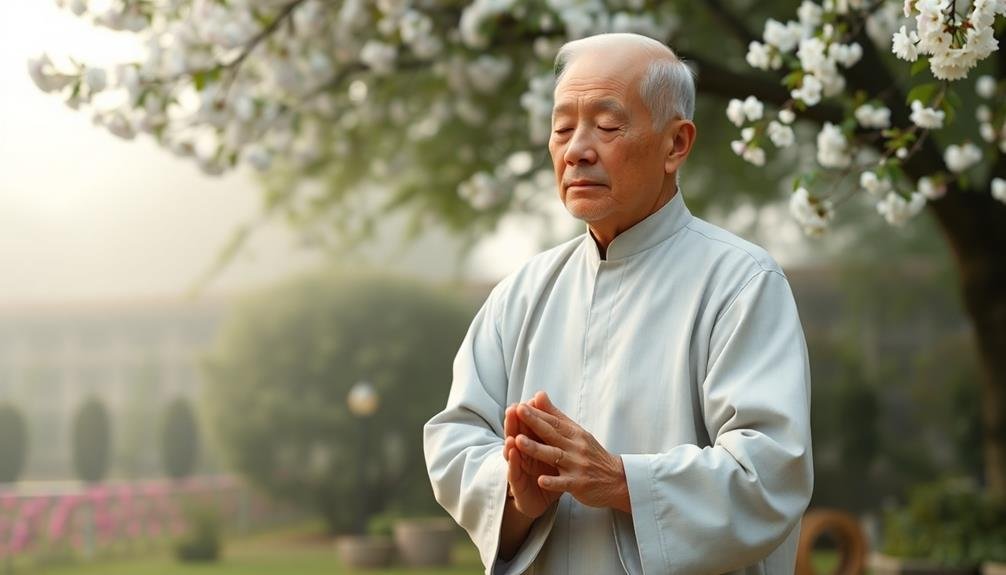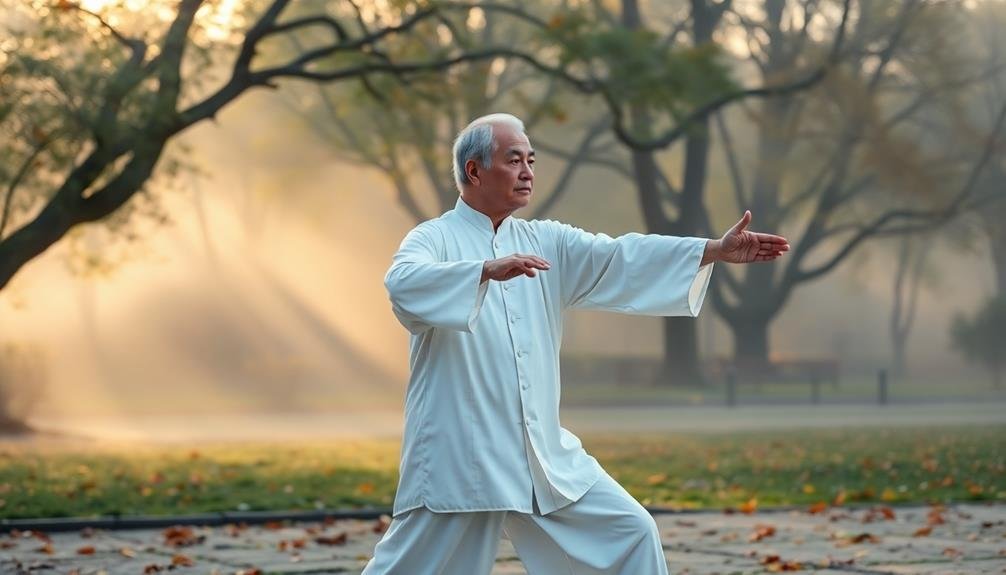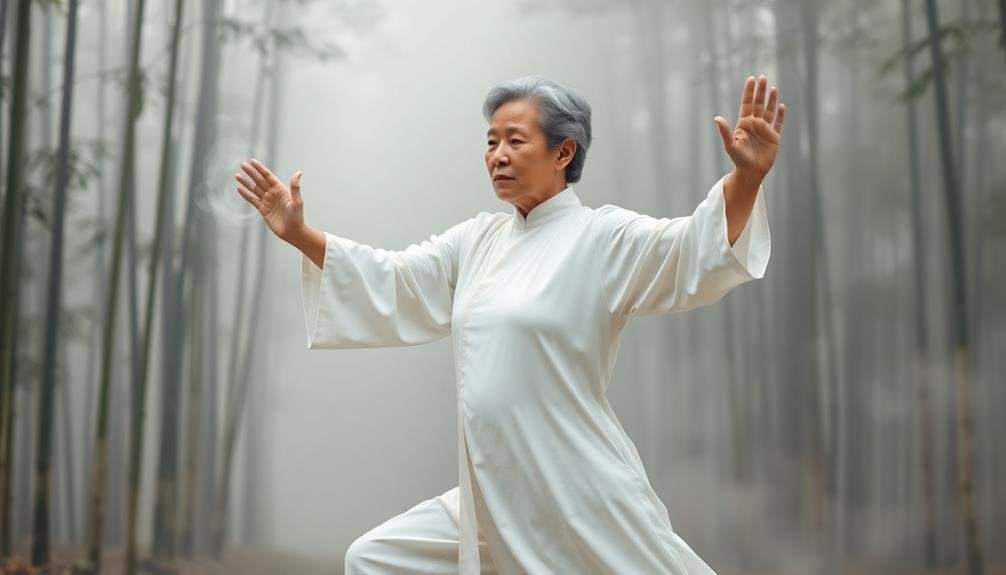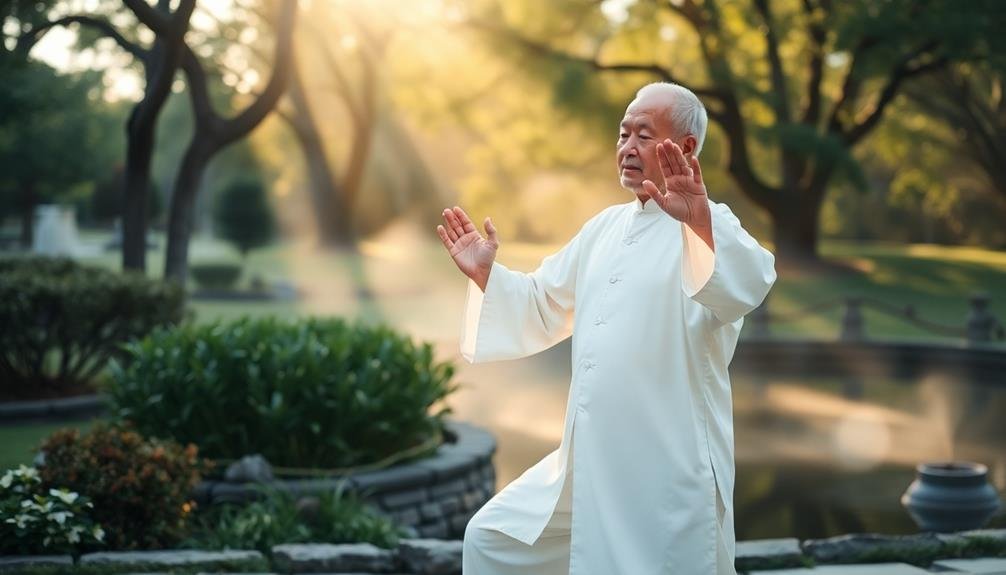Tai Chi breathing offers a powerful ancient solution to modern anxiety. By combining gentle movements with mindful breath control, you'll tap into centuries-old wisdom for inner peace. Focus on deep diaphragmatic breathing, inhaling through your nose and exhaling through your mouth while expanding your lower abdomen. Synchronize your breath with slow, flowing movements to activate your body's relaxation response. Regular practice can reduce stress, improve focus, and enhance overall well-being. You'll learn to anchor yourself in the present moment, letting go of worries about the future or past. Discover how this time-tested technique can transform your approach to anxiety management and cultivate lasting serenity.
Understanding Tai Chi Breathing Basics

Tai Chi breathing techniques form the foundation of this ancient Chinese practice. They're designed to synchronize your breath with your movements, promoting relaxation and mindfulness. The core principle is deep, diaphragmatic breathing, where you inhale slowly through your nose, allowing your abdomen to expand, then exhale gently through your mouth.
You'll want to focus on breathing from your lower abdomen, also known as the "dan tien" in Chinese philosophy. This area is considered the body's energy center. As you practice, you'll learn to direct your breath to this region, fostering a sense of groundedness and calm.
Tai Chi breathing emphasizes a natural, relaxed rhythm. You're not forcing or controlling your breath, but rather allowing it to flow smoothly and effortlessly. This approach helps reduce tension in your body and mind.
One key aspect is maintaining awareness of your breath throughout your practice. You'll coordinate your inhalations and exhalations with specific movements, creating a meditative flow that can greatly reduce anxiety and stress.
With consistent practice, you'll find these breathing techniques become second nature, benefiting you both during Tai Chi sessions and in everyday life.
Historical Roots of Anxiety Relief
The practice of using breath to alleviate anxiety has deep historical roots, stretching back thousands of years. In ancient China, Taoist philosophers developed breathing techniques as part of their quest for longevity and inner peace. They believed that proper breathing could balance the body's energy and promote mental clarity.
You'll find similar practices in India's yoga tradition, where pranayama (breath control) has been used for centuries to calm the mind and reduce stress. Buddhist meditation also incorporates mindful breathing to achieve tranquility and insight.
In the West, the Greeks and Romans recognized the connection between breath and emotional state. Stoic philosophers advocated controlled breathing to maintain composure in challenging situations.
Modern science has since validated these ancient practices. Research shows that deep, slow breathing activates the parasympathetic nervous system, reducing heart rate and blood pressure. This physiological response helps counteract the effects of stress and anxiety.
Tai Chi's breathing techniques draw from this rich historical tapestry, combining ancient wisdom with contemporary understanding. By practicing these time-tested methods, you're tapping into a tradition that has helped countless individuals find relief from anxiety throughout history.
The Science Behind Tai Chi

While ancient practitioners relied on intuition and experience, modern research has validated the effectiveness of Tai Chi for anxiety relief. Scientific studies have shown that Tai Chi's combination of slow, deliberate movements and focused breathing can greatly reduce stress and anxiety levels. The practice activates your parasympathetic nervous system, promoting relaxation and counteracting the fight-or-flight response associated with anxiety.
Tai Chi's impact on anxiety can be attributed to three key factors:
- Mindfulness: By focusing on your movements and breath, you're anchored in the present moment, reducing worry about the future or past.
- Physical activity: The gentle exercise releases endorphins, natural mood elevators that help combat anxiety.
- Breathing techniques: Deep, diaphragmatic breathing increases oxygen flow to your brain, promoting calmness and mental clarity.
Neuroimaging studies have revealed that regular Tai Chi practice can actually alter brain structure, increasing gray matter volume in areas associated with emotional regulation.
This neuroplasticity suggests that Tai Chi may offer long-term benefits for anxiety management, potentially rewiring your brain's response to stress triggers over time.
Mastering Diaphragmatic Breathing Technique
Central to Tai Chi's anxiety-relieving effects is the practice of diaphragmatic breathing. This technique involves breathing deeply from your diaphragm, rather than shallow chest breathing.
To master it, start by lying on your back with one hand on your chest and the other on your belly. As you inhale through your nose, focus on expanding your belly while keeping your chest relatively still. Exhale slowly through your mouth, feeling your belly fall.
Once you've got the hang of it lying down, try it sitting up. Maintain good posture with your shoulders relaxed. Breathe in through your nose for a count of four, hold for two, then exhale through your mouth for six counts. This 4-2-6 pattern helps activate your parasympathetic nervous system, reducing anxiety.
Practice this technique daily, gradually increasing the duration. You'll find it becomes more natural over time. Incorporate it into your Tai Chi routine, synchronizing your breath with your movements.
Integrating Movement With Breath

As you practice Tai Chi, you'll learn to synchronize your breath with your movements.
This coordination allows you to flow energy through your body more effectively, enhancing the calming effects of the practice.
Synchronizing Breath and Motion
At the heart of Tai Chi lies the seamless integration of breath and movement. As you progress in your practice, you'll learn to synchronize your breathing with each motion, creating a harmonious flow that calms your mind and body. This synchronization is key to releasing the full potential of Tai Chi for anxiety relief.
To achieve this synchronization, focus on the following:
- Timing: Inhale as you prepare for a movement, and exhale as you execute it. This pattern helps you maintain a steady rhythm and enhances your body's natural energy flow.
- Depth: Match the depth of your breath to the intensity of the movement. Deeper breaths complement more expansive motions, while shallow breaths pair with subtle gestures.
- Awareness: Pay attention to how your breath affects each movement. Notice how inhalations create a sense of lightness and expansion, while exhalations promote grounding and stability.
As you practice, you'll find that this synchronization becomes more natural and effortless. Your breath will guide your movements, and your movements will, in turn, influence your breath.
This reciprocal relationship forms the foundation of Tai Chi's powerful anxiety-reducing effects.
Flowing Energy Through Body
The synchronization of breath and movement in Tai Chi sets the stage for a deeper exploration of energy flow throughout your body. As you practice, you'll begin to feel a subtle current of energy, known as "qi," moving within you. This energy follows your breath and enhances the effectiveness of your movements.
To cultivate this energy flow, focus on your dan tien, an area just below your navel. As you inhale, imagine drawing energy into this center. When you exhale, visualize the energy expanding outward through your limbs. With each movement, direct this energy along the path of your motion.
You'll notice that certain Tai Chi forms emphasize specific energy pathways. For example, "Wave Hands Like Clouds" encourages energy to flow through your arms and hands. As you perform this movement, feel the energy extending beyond your fingertips.
Daily Tai Chi Breathing Exercises
Start your day with a Morning Breath Awareness Practice to set a calm tone for the hours ahead.
As you wind down in the evening, incorporate Evening Stress-Release Techniques to shed accumulated tension.
Morning Breath Awareness Practice
Mornings offer a perfect opportunity to begin your daily Tai Chi breathing practice. As you wake up, take a moment to tune into your breath before starting your day. This morning breath awareness practice can help set a calm and centered tone for the hours ahead.
Start by finding a comfortable seated position, either on your bed or a chair. Close your eyes and focus on your natural breathing rhythm. Don't try to change it; simply observe. As you become more aware of your breath, gradually deepen your inhalations and exhalations.
To enhance your morning breath awareness practice, try these three techniques:
- Counting breaths: Count each inhale and exhale cycle up to ten, then start over.
- Belly breathing: Place one hand on your abdomen and feel it rise and fall with each breath.
- Visualizing energy: Imagine drawing in positive energy with each inhale and releasing tension with each exhale.
Aim to practice this morning breath awareness for 5-10 minutes daily. You'll likely notice improved focus, reduced anxiety, and a greater sense of calm throughout your day.
Evening Stress-Release Techniques
After a long day filled with various stressors, evening Tai Chi breathing exercises can help you unwind and release accumulated tension. These techniques focus on slow, deliberate movements paired with deep breathing to calm your mind and relax your body.
Start by finding a quiet space where you won't be disturbed. Stand with your feet shoulder-width apart and your knees slightly bent. Close your eyes and take a few deep breaths to center yourself. Then, try these evening stress-release techniques:
| Exercise | Duration | Benefits |
|---|---|---|
| Gathering Qi | 5 minutes | Increases energy flow |
| Embracing the Moon | 3 minutes | Promotes relaxation |
| Pushing the Wave | 4 minutes | Releases tension |
| Clearing the Mind | 2 minutes | Calms thoughts |
As you perform these exercises, focus on your breath and visualize the stress leaving your body with each exhale. Remember to move slowly and deliberately, allowing your muscles to relax and your mind to clear. With regular practice, you'll find these evening Tai Chi breathing techniques become an essential part of your daily stress-management routine.
Overcoming Anxiety Through Mindfulness

Embracing mindfulness can be a powerful tool in your battle against anxiety. By focusing on the present moment and accepting your thoughts and feelings without judgment, you'll gradually reduce the grip anxiety has on your life.
Mindfulness helps you recognize anxious thoughts as temporary mental events rather than absolute truths, allowing you to respond to them more effectively.
To incorporate mindfulness into your daily routine and combat anxiety:
- Start with short, guided meditations: Use apps or online resources to practice 5-10 minute sessions, gradually increasing duration as you become more comfortable.
- Practice mindful breathing: Take a few minutes each day to focus solely on your breath, noticing its rhythm and sensation without trying to change it.
- Engage in mindful activities: Choose a daily task like eating or walking and perform it with full attention, observing sensations, thoughts, and emotions as they arise.
Benefits Beyond Anxiety Management
While Tai Chi breathing techniques are often lauded for their anxiety-reducing effects, they offer a wealth of benefits that extend far beyond stress management. You'll find that regular practice can greatly improve your overall physical health. These techniques enhance your lung capacity, leading to better oxygen circulation throughout your body. This increased oxygenation can boost your energy levels and improve your endurance during physical activities.
Moreover, Tai Chi breathing exercises can help balance your autonomic nervous system, promoting better heart health and lowering blood pressure. You'll likely notice improved digestion and a stronger immune system as well.
The mindfulness aspect of these techniques can sharpen your focus and cognitive function, potentially enhancing your memory and decision-making skills.
Tai Chi breathing also fosters better sleep quality, helping you fall asleep faster and enjoy more restorative rest. You may experience improved posture and balance, reducing the risk of falls, especially as you age.
Additionally, these practices can alleviate chronic pain conditions and enhance your body's natural healing processes. By incorporating Tai Chi breathing into your daily routine, you're investing in your long-term health and well-being.
Incorporating Tai Chi Into Routines

To seamlessly weave Tai Chi breathing into your daily life, start with small, consistent steps. Begin by setting aside just five minutes each morning for focused Tai Chi breathing exercises. As you become more comfortable, gradually increase the duration and frequency of your practice.
Identify key moments throughout your day when you can incorporate Tai Chi breathing techniques:
- During your commute: Practice deep, rhythmic breathing while sitting in traffic or on public transportation.
- Before important meetings: Take a few minutes to center yourself with Tai Chi breathing, reducing stress and improving focus.
- During breaks: Use short periods of downtime to engage in gentle Tai Chi movements and breathing exercises.
Don't forget to create a dedicated space in your home for Tai Chi practice. This area doesn't need to be large; a small corner with enough room to move freely is sufficient.
Keep it clutter-free and add elements that promote relaxation, such as plants or calming artwork.
Advanced Breathing Techniques for Serenity
As you progress in your Tai Chi practice, you'll encounter more advanced breathing techniques to enhance your serenity.
Reverse Abdominal Breathing, a method that involves contracting the abdomen during inhalation and expanding it during exhalation, can deepen your relaxation response.
Another powerful technique is the Nine Bottle Breath Method, which focuses on visualizing your breath flowing through nine specific points in your body, promoting a heightened sense of calm and body awareness.
Reverse Abdominal Breathing
Reverse abdominal breathing, a cornerstone of advanced Tai Chi practice, offers a powerful technique for deepening your relaxation and enhancing serenity. Unlike normal breathing, this method involves contracting your abdomen during inhalation and expanding it during exhalation. This reversal creates a gentle massage for your internal organs and stimulates your parasympathetic nervous system, promoting a state of calm.
To practice reverse abdominal breathing:
- Sit comfortably with your spine straight and place one hand on your chest and the other on your abdomen.
- Inhale slowly through your nose, drawing your abdomen in towards your spine while keeping your chest relatively still.
- Exhale gradually through your mouth, allowing your abdomen to expand outward.
Start with short sessions of 3-5 minutes and gradually increase the duration as you become more comfortable.
You'll notice improved focus, reduced anxiety, and a greater sense of overall well-being. Remember, consistency is key in reaping the full benefits of this ancient technique.
With regular practice, you'll develop a deeper connection between your breath, body, and mind, enhancing your Tai Chi practice and daily life.
Nine Bottle Breath Method
Building on the foundations of reverse abdominal breathing, the Nine Bottle Breath Method offers an advanced technique for achieving profound serenity. This method involves visualizing nine bottles arranged in three rows of three, each representing a different area of your body.
Begin by sitting comfortably and closing your eyes. As you inhale, imagine filling the first bottle in the bottom row, representing your lower abdomen. Continue inhaling, filling the second and third bottles in that row. Move to the middle row, filling bottles four, five, and six, which represent your chest area. Finally, fill the top row, bottles seven, eight, and nine, corresponding to your throat and head.
As you exhale, reverse the process, emptying the bottles from top to bottom. Start with the ninth bottle and work your way down, releasing tension from each area as you go. Practice this technique for 5-10 minutes, focusing on smooth, controlled breaths.
The Nine Bottle Breath Method helps you develop greater body awareness and promotes deep relaxation. It's particularly effective for reducing anxiety by encouraging full, mindful breathing and systematic tension release throughout your entire body.
Frequently Asked Questions
Can Tai Chi Breathing Exercises Be Practiced During Pregnancy?
Yes, you can practice tai chi breathing exercises during pregnancy. They're generally safe and can help you relax, reduce stress, and improve your overall well-being. However, it's always best to consult your healthcare provider before starting any new exercise routine.
How Long Does It Take to See Results From Tai Chi Breathing?
You'll typically notice initial results from regular breathing exercises within a few weeks. However, it's important to remember that everyone's experience differs. Stick with it, and you'll likely see more significant benefits over time.
Are There Any Potential Side Effects of Tai Chi Breathing Techniques?
You're unlikely to experience side effects from tai chi breathing techniques. They're generally safe and gentle. However, you might feel lightheaded if you're not used to deep breathing. Always listen to your body and stop if you're uncomfortable.
Can Children Benefit From Learning Tai Chi Breathing Exercises?
Yes, children can benefit from learning tai chi breathing exercises. You'll find they help improve focus, reduce stress, and enhance body awareness. They're safe, gentle, and can be adapted for kids of various ages and abilities.
Is It Necessary to Have a Tai Chi Instructor for Breathing Practices?
You don't necessarily need an instructor for breathing practices. While guidance can be helpful, you can learn basic techniques from books, videos, or apps. Start with simple exercises and progress at your own pace. Self-practice can be effective.
In Summary
You've now discovered the power of Tai Chi breathing to conquer anxiety. By embracing this ancient practice, you're tapping into centuries of wisdom and modern scientific backing. Remember, it's not just about the breath—it's the mindful integration of movement and awareness that'll transform your mental state. As you continue to practice, you'll find benefits extending far beyond anxiety relief. Keep breathing, keep moving, and watch as serenity becomes your new normal.





Leave a Reply